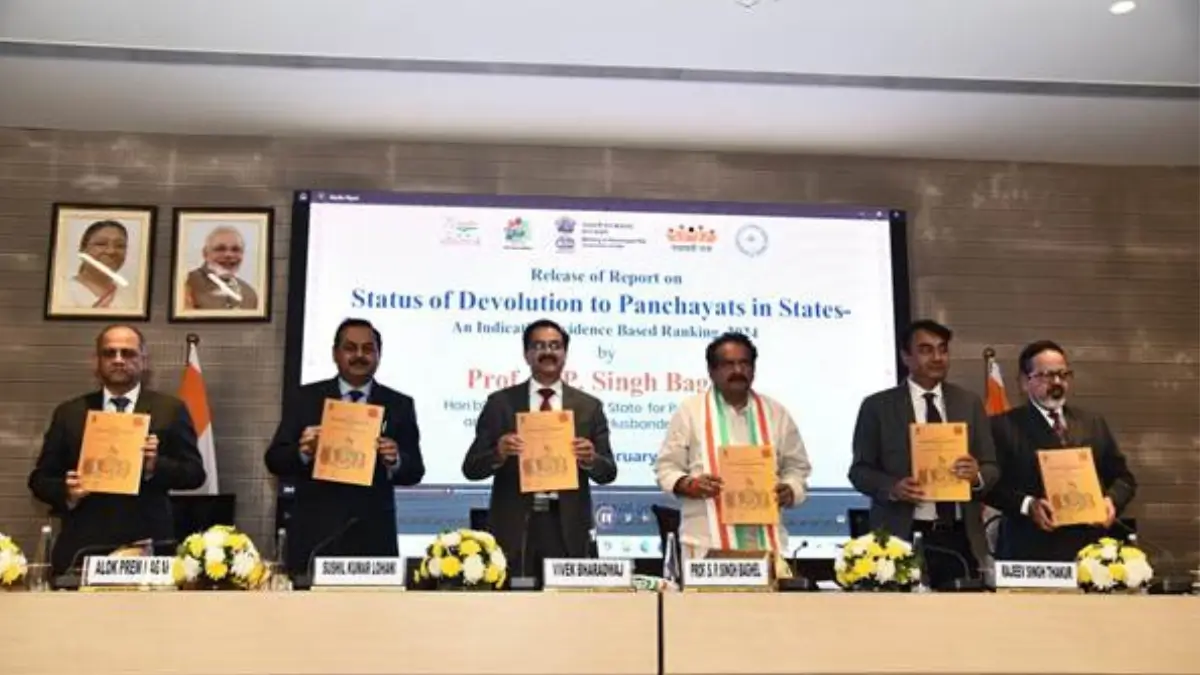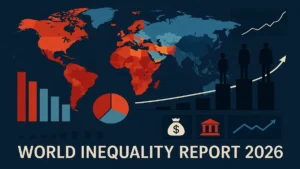In a significant step towards strengthening local governance, Union Minister of State for Panchayati Raj, Prof. S.P. Singh Baghel, unveiled the report titled “Status of Devolution to Panchayats in States – An Indicative Evidence-Based Ranking” in New Delhi. The report assesses the extent of power, functions, and financial devolution to Panchayati Raj Institutions (PRIs) across various Indian states.
The report highlights a steady increase in devolution to Rural Local Bodies (RLBs), from 39.9% in 2013-14 to 43.9% in 2021-22. It provides valuable insights into state performances, ranking them based on their devolution index.
Importance of the Devolution Report
While releasing the report, Prof. S.P. Singh Baghel emphasized that the Panchayat Devolution Index is essential for holistic, inclusive, and sustainable development in India. The ranking serves two key purposes:
- Recognizing top-performing states that have empowered their Panchayats effectively.
- Encouraging other states to create an environment that fosters rural self-governance.
The Minister further highlighted Uttar Pradesh’s significant improvement, which climbed from 15th to 5th position, citing its innovative transparency initiatives and robust anti-corruption measures as key factors.
Key Highlights from the Report
1. Growth in Panchayat Devolution
The report presents a remarkable improvement in the devolution of power and resources to Panchayats:
- Overall Devolution Index increased from 39.9% in 2013-14 to 43.9% in 2021-22.
- Capacity enhancement index rose from 44% to 54.6% after the launch of Rashtriya Gram Swaraj Abhiyan (RGSA) in 2018.
- The functionaries index improved from 39.6% to 50.9%, indicating a better workforce and infrastructure in Panchayats.
2. Top-Performing States in Panchayat Devolution Index
Based on the Devolution Index, the top 10 states in empowering Panchayati Raj Institutions (PRIs) are:
| Rank | State |
|---|---|
| 1st | Karnataka |
| 2nd | Kerala |
| 3rd | Tamil Nadu |
| 4th | Maharashtra |
| 5th | Uttar Pradesh |
| 6th | Gujarat |
| 7th | Tripura |
| 8th | Rajasthan |
| 9th | West Bengal |
| 10th | Chhattisgarh |
Additionally, Andhra Pradesh, Himachal Pradesh, Madhya Pradesh, and Odisha were classified as medium-scoring states, showcasing commendable performance.
3. Dimensional Analysis of Devolution
The report evaluated states across six key dimensions:
- Framework – Legal provisions ensuring strong governance (Leader: Kerala)
- Functions – Effective functional devolution (Leader: Tamil Nadu)
- Finances – Financial management & resource allocation (Leader: Karnataka)
- Functionaries – Staffing & personnel efficiency (Leader: Gujarat)
- Capacity Enhancement – Institutional strengthening (Leader: Telangana)
- Accountability – Transparency & anti-corruption measures (Leader: Karnataka)
4. Success Stories: Uttar Pradesh and Tripura
- Uttar Pradesh demonstrated a historic improvement from 15th to 5th position, revolutionizing its accountability framework with transparency and anti-corruption initiatives.
- Tripura improved from 13th to 7th position, particularly excelling in revenue generation and fiscal management.
Significance of Strengthening Panchayati Raj Institutions (PRIs)
The 73rd Constitutional Amendment granted constitutional status to Panchayats, aiming to make them self-reliant governance institutions. Over three decades, there has been substantial variation in devolution levels across states.
Prof. Baghel stressed that Panchayat Bhawans should serve as rural development hubs, offering services like:
- Issuance of pensions, birth & death certificates
- Enrollment in government welfare schemes (e.g., Ayushman Bharat Yojana)
- Conflict resolution & community development initiatives
Ensuring Financial Accountability
A crucial aspect discussed in the report was fund monitoring to prevent financial irregularities and corruption. Prof. Baghel emphasized:
- Transparent utilization of funds to ensure targeted development.
- Regular audits & accountability mechanisms.
- Increased participation of local communities in governance.
Government’s Vision for Strengthening Local Governance
1. Role of Panchayats in Viksit Bharat
The government envisions Viksit Bharat through Gram Swaraj, echoing Mahatma Gandhi’s dream of self-reliant village republics. This aligns with Prime Minister Narendra Modi’s focus on decentralization and rural empowerment.
2. Digital Transformation in Panchayats
The report highlights significant improvements in:
- Digital Infrastructure – Panchayats now have computers, internet connectivity & modern office buildings.
- Transparent Accounting & Audits – Ensuring financial discipline at the local level.
- Regular Elections & Reservations – Enabling inclusive governance with representation for women & marginalized communities.
Summary of the Report on Devolution to Panchayats
| Section | Details |
|---|---|
| Why in News? | Union Minister of State for Panchayati Raj, Prof. S.P. Singh Baghel, released the report “Status of Devolution to Panchayats in States – An Indicative Evidence-Based Ranking” in New Delhi. The report evaluates the extent of power, functions, and financial devolution to Panchayati Raj Institutions (PRIs). |
| Growth in Devolution | – Overall Devolution Index increased from 39.9% (2013-14) to 43.9% (2021-22). – Capacity enhancement index rose from 44% to 54.6% post Rashtriya Gram Swaraj Abhiyan (RGSA) 2018. – Functionaries index improved from 39.6% to 50.9%, indicating better workforce & infrastructure. |
| Top 10 States in Panchayat Devolution Index |
|
| Dimensional Analysis (Leaders in Each Category) |
|
| Success Stories | – Uttar Pradesh improved from 15th to 5th position, credited to transparency & anti-corruption initiatives. – Tripura rose from 13th to 7th, excelling in revenue generation & fiscal management. |
| Significance of Strengthening PRIs | – The 73rd Constitutional Amendment granted constitutional status to Panchayats. – PRIs should serve as rural development hubs offering services like:
|
| Financial Accountability Measures |
|
| Government’s Vision for Strengthening PRIs |
|



 TIME Magazine Names ‘Architects of AI’ a...
TIME Magazine Names ‘Architects of AI’ a...
 World Inequality Report 2026: Key Findin...
World Inequality Report 2026: Key Findin...
 Indian-Origin Arkin Gupta Named in Forbe...
Indian-Origin Arkin Gupta Named in Forbe...







